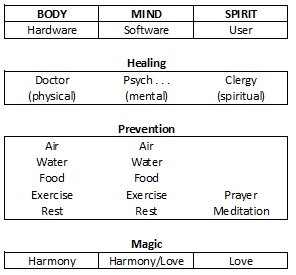In previous issues of Computer Times, we printed a 26-month series from the book titled Get The MOST from Yourself, by Dr. Terry Kibiloski. This is the third article of that series.
Understanding the Human System
Last month, we focused on the question “What about you?” and helped you answer the questions: Where are you today in your life journey? Where do you want to be? Is the student ready? (The teacher is ready to appear.) This month, we begin with the section titled What is the human system? We will focus on the first topic area of this section titled What are the components of the human system?
What is the human system?
The human system refers to YOU as an individual, and to the larger human system which is made up of all of us. In a healthy human system, people take control of their own lives to get the MOST from themselves. How well you control yourself as an individual will determine your overall health and happiness, and the health of the larger human system to which we all belong. The main focus of this book is your personal human system.
Why do we use the term “Human System?” If you look at all of creation, you will find many systems: solar system, ecological system, weather system, etc. Each system can be broken down into components that must work together to form a healthy system. Thus, we have the principal:
For a system to be healthy, all components must work in perfect harmony.
This applies to natural systems, as well as to manmade systems like political systems and business systems. This applies especially to the human system.
Throughout creation, you will find similarities among various systems. For example, the earth is made up of 70% water, all plant life is made up of 70% water, all human beings are made up of 70% water. These similarities are found throughout creation, suggesting a master plan from a higher intelligence. In addition to the similarities found among various systems, you will find that various systems are interconnected, having a direct impact on each other. This gives us the principle:
Systems are interconnected throughout creation and have a direct impact on each other.
We can see examples of this within our own human system which is made up of many other systems: respiratory system, cardiovascular system, circulatory system, etc. If one of our internal systems is unhealthy, it has a direct impact on the overall health of our other internal systems and our overall human system, which can then impact the greater human system. For example, if you have a respiratory illness like pneumonia, every system in your body is adversely affected by a reduction in life sustaining oxygen which can, in turn, cause further breakdowns in every system in your body. Our ill health can then impact those around us in various ways thus having a direct impact on other systems like our family system, business system, etc.
What are the components of the human system?
To help you understand the components of the human system, we need to look at the Body-Mind-Spirit chart we use in some of our Human System seminars (see chart below).
It is important to understand that our spirit controls our mind and, in turn, our mind controls our body. While this may be a new concept to you, it is firmly founded in scripture and ancient writings. One example is found in the New International Version of the Christian Bible in Paul’s letter to the Romans, chapter 8, verse 6, “The mind controlled by the Spirit is life and peace.” There are many references throughout ancient and modern writings to this principle of the mind being controlled by the spirit. This is an important principle to understand as it is the underlying principle of the basis for our human system:
We are spirits having a human experience.
Beneath the top labels of Body, Mind and Spirit are the words Hardware, Software, and User to show the parallel between a computer and ourselves. As a computer user uses the hardware and software to have a computing experience, we (as spirits) use our body and mind to have a human experience.
The next section of the chart is the “healing” section. This shows the mode many people are in most of their lives. As their internal ease turns to dis-ease, they go to doctors to help heal the physical; psychotherapists, psychiatrists, psych . . ., to help heal the mental; and clergy/spiritual leaders to help heal the spiritual.
As we begin to understand more about ourselves, and decide to take control of our human experience, we progress to the “prevention” section of our chart. We begin making healthy choices and provide the steady supply of pure air, clean water, fresh food, exercise, and rest each of our cells needs to stay healthy. Notice that our spirit does not require air, water, and food, but it does require the spiritual equivalent of exercise and rest, called prayer and meditation.
As we continue to progress in our life journey, we realize that health is not enough, we need to use our health to apply the real “magic” of the human experience. We soon discover this magic is harmony and unconditional love.
Next month we will look at the health of YOUR human system.
Now, we share an article a friend sent us over the Internet.
KEEP YOUR FORK
There was a woman who had been diagnosed with a terminal illness and had been given three months to live. So as she was getting her things “in order,” she contacted her pastor and had him come to her house to discuss certain aspects of her final wishes.
She told him which songs she wanted sung at the service, what scriptures she would like read, and what outfit she wanted to be buried in. The woman also requested to be buried with her favorite Bible. Everything was in order and the pastor was preparing to leave when the woman suddenly remembered something very important to her.
“There’s one more thing,” she said excitedly. “What’s that?” came the pastor’s reply. “This is very important,” the woman continued. “I want to be buried with a fork in my right hand.” The pastor stood looking at the woman, not knowing quite what to say. “That surprises you, doesn’t it?” the woman asked. “Well, to be honest, I’m puzzled by the request,” said the pastor.
The woman explained. “In all my years of attending church socials and potluck dinners, I always remember that when the dishes of the main course were being cleared, someone would inevitably lean over and say, ‘Keep your fork.’ It was my favorite part because I knew that something better was coming…like velvety chocolate cake or deep-dish apple pie. Something wonderful, and with substance! So, I just want people to see me there in that casket with a fork in my hand and I want them to wonder “What’s with the fork?”. Then I want you to tell them: “Keep your fork….the best is yet to come”.
The pastor’s eyes welled up with tears of joy as he hugged the woman goodbye. He knew this would be one of the last times he would see her before her death. But he also knew that the woman had a better grasp of heaven than he did. She KNEW that something better was coming.
At the funeral people were walking by the woman’s casket and they saw the pretty dress she was wearing and her favorite Bible and the fork placed in her right hand. Over and over, the pastor heard the question “What’s with the fork?” And over and over he smiled. During his message, the pastor told the people of the conversation he had with the woman shortly before she died. He also told them about the fork and about what it symbolized to her. The pastor told the people how he could not stop thinking about the fork and told them that they probably would not be able to stop thinking about it either. He was right.
So the next time you reach down for your fork, let it remind you, oh so gently, that the best is yet to come.
Friends are a very rare jewel, indeed. They make you smile and encourage you to succeed. They lend an ear, they share a word of praise, and they always want to open their hearts to us. Show your friends how much you care. Send this to everyone you consider a FRIEND.
Much more next month . . . Get the Most from Yourself – Chapter 3
IMPORTANT NOTICE: This file is protected by copyright laws. It may not be copied or reproduced in any way without the expressed permission from the author, Dr. Terry Kibiloski. Readers who purchase a copy of this file from Computer Times, may make a printed copy for their personal use only.


